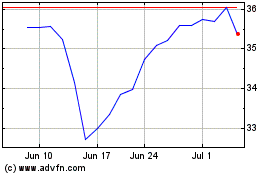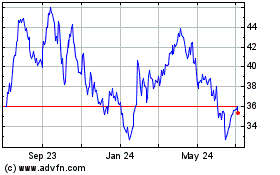Natural Gas Stockpiles Up 95 Bcf - Analyst Blog
July 11 2011 - 10:08AM
Zacks
The U.S. Energy Department's weekly
inventory release showed a larger-than-expected build-up in natural
gas supplies on the back of above-average growth in each of the
three storage regions.
This was partially offset by a
strong uptick in demand in the power sector, mainly due to high
temperatures in the Northeast.
The Weekly Natural Gas Storage
Report – brought out by the Energy Information Administration (EIA)
every Thursday since 2002 – includes updates on natural gas market
prices, the latest storage level estimates, recent weather data and
other market activity or events.
The report provides an overview of
the level of reserves and their movements, thereby helping
investors understand the demand/supply dynamics of natural gas.
It is an indicator of current gas
prices and volatility that affect businesses of natural
gas-weighted companies and related support plays like
Anadarko Petroleum Corp. (APC),
Chesapeake Energy (CHK),
EnCana Corp. (ECA), Devon
Energy Corp. (DVN), Nabors
Industries (NBR), Patterson-UTI
Energy (PTEN), Helmerich &
Payne (HP) and Halliburton Co.
(HAL).
Stockpiles held in underground
storage in the lower 48 states rose by 95 billion cubic feet (Bcf)
for the week ended July 1, 2011, higher than expectations of
analysts for 78–82 Bcf surveyed by Platts, the energy information
arm of McGraw-Hill Companies Inc
(MHP).
The increase – the thirteenth
injection in as many weeks – is bigger than both last year’s
build-up of 73 Bcf and the 5-year (2006–2010) average build-up of
80 Bcf for the reported week. The current storage level at 2.527
trillion cubic feet (Tcf) is down 224 Bcf (8.1%) from last year and
is 48 Bcf (1.9%) below the five-year average.
A supply glut had pressured natural
gas futures for most of 2010, as production from dense rock
formations (shale) – through novel techniques of horizontal
drilling and hydraulic fracturing – remained robust, thereby
overwhelming demand.
Storage amounts hit a record high
of 3.840 Tcf in November, while gas prices during the year fell
21%. As a matter of fact, natural gas prices have dropped nearly
70% from a peak of about $13.60 per million Btu (MMBtu) to the
current level of around $4.35, in between sinking to a low of $2.50
in September 2009.
However, stocks of the commodity
slid approximately 2.261 Tcf during the five-month period (November
5, 2010 to April 1, 2011) on the back of a colder-than-normal end
to this past winter, production freeze-offs in January/February,
and the steadily declining rig count. These factors cut into the
U.S. supply overhang, thereby creating a deficit in natural gas
inventories after erasing the hefty surplus over last year’s
inventory level and the five-year average level.
But with the end of the winter's
peak in heating demand, natural gas prices continue to be under
pressure against the backdrop of sustained strong production.
Producers are now hoping that the gap between supply and demand
will further narrow in the coming months as they bet on a
hotter-than-expected summer and an active hurricane season.
ANADARKO PETROL (APC): Free Stock Analysis Report
CHESAPEAKE ENGY (CHK): Free Stock Analysis Report
DEVON ENERGY (DVN): Free Stock Analysis Report
ENCANA CORP (ECA): Free Stock Analysis Report
HALLIBURTON CO (HAL): Free Stock Analysis Report
HELMERICH&PAYNE (HP): Free Stock Analysis Report
MCGRAW-HILL COS (MHP): Free Stock Analysis Report
NABORS IND (NBR): Free Stock Analysis Report
PATTERSON-UTI (PTEN): Free Stock Analysis Report
Zacks Investment Research
Helmerich and Payne (NYSE:HP)
Historical Stock Chart
From Apr 2024 to May 2024

Helmerich and Payne (NYSE:HP)
Historical Stock Chart
From May 2023 to May 2024
